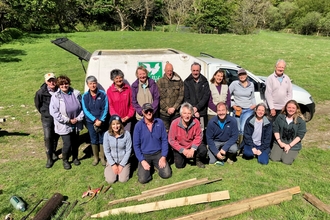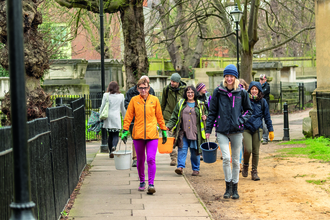What is a risk assessment?
You do a risk assessment before you do anything and you probably don’t even realise you’re doing it! It just refers to what you think about before you do something. You’ll do them all the time – before you cross the road, for example.
A risk assessment that you don’t write down, and just do in your head, is called a “dynamic risk assessment”. The other type of risk assessment is a “formal risk assessment”. You write these down and keep them as a record.
Risk assessments for community groups (https://www.youtube.com/watch?v=TxoGySN9AiI)
A short animation about risk assessments, why they are important, and how to do one.
Everything has some kind of risk. Don’t worry if your activity has risks. The risk assessment will help you work out what those risks are, and what you can do about them.
Hazards and risks
A hazard is something that could cause harm.
A risk assessment looks at all the hazards, and works out how harmful they are. It also works out how likely it is that the hazard happens. A hazard that is both very likely AND very harmful would be too dangerous to do.
We use a “matrix” to score hazards. These can have a different number of boxes. Below is a simple version.
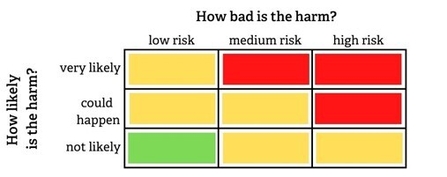

If something is high risk (might kill you) AND very likely – the box is red. If something falls in the yellow boxes, then you need to decide whether you can make the risk less likely, or the harm caused smaller.
The things you put in place to make the risk less or the harm smaller are called “control measures”.
Here’s an example:
A group wants to clear a patch of wasteland. They do a risk assessment. They find out the risks are nettles and using chainsaws.
How likely are nettle stings? Very likely. How harmful are they? Not very harmful. But because they are so likely, they fall into a red box on the risk assessment matrix. So, the group puts a control measure in place – they give everyone gloves. Now, everyone is much less likely to be stung.
What about the use of chainsaws. The group has one chainsaw. What’s the harm? This could be very harmful indeed. But how likely is it to cause harm? The group see that only one person is allowed to use a chainsaw and they have been properly trained. They have all the right safety equipment. This means the likelihood of anything going wrong is very low indeed – as long as all the rules are followed.
The paperwork
Keep copies of your risk assessments. Make sure they are dated.
Do you have someone who is responsibly for health and safety? It can be useful to have trained first aiders, too. If you have a written Health and Safety Policy, this can be very useful when you’re applying for funds or want to hire premises. Review your policy every year.
Keep an “accident book”. If someone is hurt, write it down, with details about how they got hurt, and what treatment they had.
Keep a list of all your equipment and keep the manuals. Think about what training people need to use the equipment, and write it down. Make sure you tell people how to use the equipment safely, and keep a record of that.
Some substances, like paint thinners, are dangerous. You’ll need to use them properly and store them safely. This comes under a rule called “Control of Substances Hazardous to Health” (or CoSHH) and you can find more information from the Health and Safety Executive.
The law
The Health and Safety at Work Act 1974 protects people doing paid work, but it’s also “strongly recommended” that groups with volunteers follow the rules too. This means providing:
- Safe equipment
- Safe substances
- The right information and training
- A safe place to work
Other things to think about
Some work with vulnerable adults and children has to be done by someone with an “enhanced criminal record check.” See our safeguarding information.
If you provide food and drink at an event, you must make sure it’s safe to eat and complies with the Food Safety Act.
Also see our related guide about Insurance for Groups.
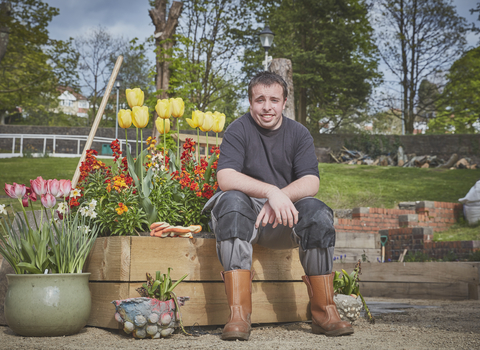
The Wildlife Trusts
Have you been part of a community nature project?
We'd love to hear from you! Your experiences will be shared right here on the Community Hub and will inspire others to take action in their own neighbourhoods.
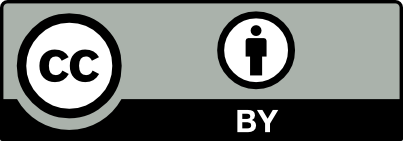
CC by 4.0 attribution
Except where noted and excluding images, company and organisation logos, this work is shared under a Creative Commons Attribution 4.0 (CC BY 4.0) Licence.
Please attribute as: “Nextdoor Nature (2022-2024) by The Wildlife Trusts funded by The National Lottery Heritage Fund, licensed under CC BY 40”



